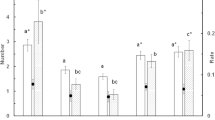Summary
The echolocation behavior ofRhinolophus rouxi when waiting for insects on a perch and when pursuing them in short hunting flights is described. It reveals that flycatcher-style hunting is one foraging strategy utilized by this species. It also suggests that bats use fluttering target information to classify their prey.
Similar content being viewed by others
References
Airapetianz ES, Konstaninov AI (1974) Echolocation in nature. Leningrad. English Translation: Joint Publications Research Service, Arlington (1974)
Blackmore M (1964) Order Chiroptera. In: Southern NH (ed) The handbook of British mammals. Blackwell Scientific Publication, Oxford, pp 224–249
Brosset A (1966) La biologie des chiroptéres. Masson, Paris
Brown PE, Berry RD (1983) Echolocation behavior in a ‘flycatcher’ bat,Hipposideros diadema. J Acoust Soc Am Suppl 1, 74:32
Eisentraut M (1950) Die ErnÄhrung der FledermÄuse. Zool J, Abt Systematik, ökol Tiere 79:115–177
Goldman LJ, Henson OW Jr (1977) Prey recognition and selection by the constant frequency bat,Pteronotus p. parnellii. Behav Ecol Sociobiol 2:411–419
Griffin DR, Simmons JA (1974) Echolocation of insects by horseshoe bats. Nature 250:731–732
Novick A (1977) Acoustic orientation. In: Wimsatt WA (ed) Biology of bats, vol III. Academic Press, New York, pp 73–287
Phillips WWA (1980) Manual of the mammals of Sri Lanka. Wildlife and Nature Protection Society of Sri Lanka, Part I, pp 45–48
Schnitzler HU (1973) Die Echoortung der FledermÄuse und ihre hörphysiologischen Grundlagen. Fortschr Zool 21:136–189
Schnitzler HU (1978) Die Detektion von Bewegungen durch Echoortung bei FledermÄusen. Verh Dtsch Zool Ges 1978, pp 16–33
Schnitzler HU, Flieger E (1983) Detection of oscillating target movements by echolocation in the greater horseshoe bat. J Comp Physiol 153:385–391
Schnitzler HU, Henson OW Jr (1980) Performance of airborne animal sonar systems: I. Microchiroptera. In: Busnel RG, Fish JF (eds) Animal sonar systems. Plenum Press, New York, pp 109–181
Schnitzler HU, Ostwald J (1983) Adaptations for the detection of fluttering insects by echolocation in horseshoe bats. In: Ewert JP, Capranica RR, Ingle DI (eds) Advances in vertebrate neuroethology. Plenum Press, New York London, pp 801–827
Schnitzler HU, Menne D, Kober R, Heblich K (1983) The acoustical image of fluttering insects in echolocating bats. In: Huber F, Markl H (eds) Neuroethology and behavioral physiology. Roots and growing points. Springer, Berlin Heidelberg New York, pp 235–250
Schuller G (1980) Hearing characteristics and Doppler shift compensation in South Indian CF-FM bats. J Comp Physiol 139:349–356
Schuller G, Beuter K, Schnitzler HU (1974) Response to frequency shifted artificial echoes in the batRhinolophus ferrumequinum. J Comp Physiol 89:275–286
Shortridge GC (1934) The mammals of south west Africa. Heinemann, London
Stebbings RE (1977) Order Chiroptera-Bats. In: Corbet, Southern (eds) The handbook of British mammals. Blackwell Publ, Oxford
Trappe M (1982) Verhalten und Echoortung der Grossen Hufeisennase beim Insektenfang. Dissertation, UniversitÄt Tübingen
Trappe M, Schnitzler HU (1982) Doppler shift compensation in insect-catching horseshoe bats. Naturwissenschaften 69:193–194
Vaughan TA (1977) Foraging behavior of the giant leaf-nosed batHipposideros commersoni. East Afr Wildl J 15:237–250
Vogler B, Neuweiler G (1983) Echolocation in the noctule (Nyctalus noctuld) and horseshoe bat (Rhinolophus ferrumequinum). J Comp Physiol 152:421–432
Walker EP (1968) Mammals of the world, vol 1. John Hopkins Press, Baltimore
Wallin L (1969) The Japanese bat fauna. Zool Bidr Uppsala 37:408–413
Author information
Authors and Affiliations
Rights and permissions
About this article
Cite this article
Schnitzler, HU., Hackbarth, H., Heilmann, U. et al. Echolocation behavior of rufous horseshoe bats hunting for insects in the flycatcher-style. J. Comp. Physiol. 157, 39–46 (1985). https://doi.org/10.1007/BF00611093
Accepted:
Issue Date:
DOI: https://doi.org/10.1007/BF00611093




